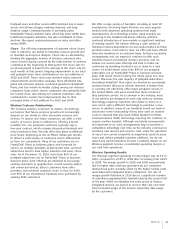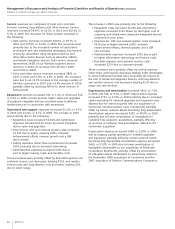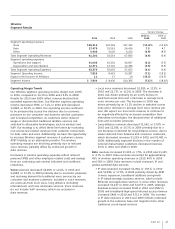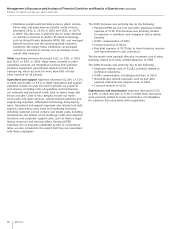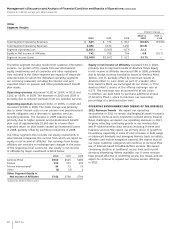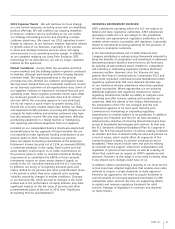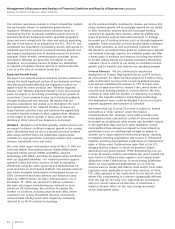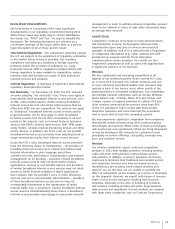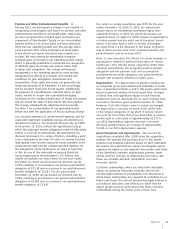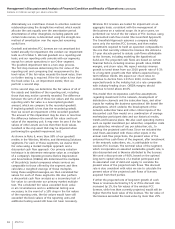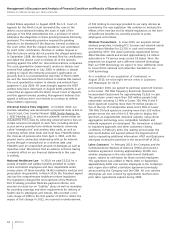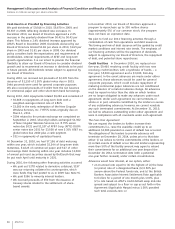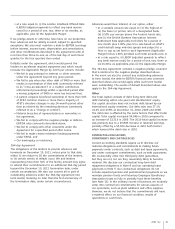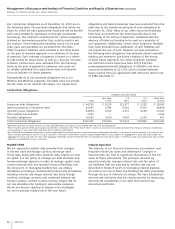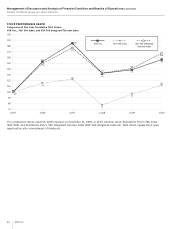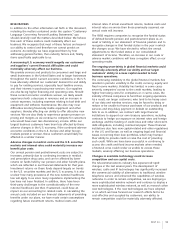AT&T Wireless 2010 Annual Report Download - page 47
Download and view the complete annual report
Please find page 47 of the 2010 AT&T Wireless annual report below. You can navigate through the pages in the report by either clicking on the pages listed below, or by using the keyword search tool below to find specific information within the annual report.
AT&T Inc. 45
Our return on assets assumption was 8.5% for the year
ended December 31, 2010. In 2010, we experienced
actual returns on investments somewhat higher than
expected; however, in 2011 we will be decreasing our
expected return on assets to 8.25%, based on expectations
on future market and the asset mix of the plans’ invest-
ments. If all other factors were to remain unchanged,
we expect that a 1.0% decrease in the actual long-term
rate of return would cause 2011 combined pension and
postretirement cost to increase $575.
Note 11 also discusses the effects of certain changes in
assumptions related to medical trend rates on retiree
healthcare costs. Should actual experience differ from
actuarial assumptions, the projected pension benefit
obligation and net pension cost and accumulated
postretirement benefit obligation and postretirement
benefit cost would be affected in future years.
Depreciation Our depreciation of assets, including use
of composite group depreciation and estimates of useful
lives, is described in Notes 1 and 5. We assign useful lives
based on periodic studies of actual asset lives. Changes
in those lives with significant impact on the financial
statements must be disclosed, but no such changes have
occurred in the three years ended December 31, 2010.
However, if all other factors were to remain unchanged,
we expect that a one-year increase in the useful lives
of the largest categories of our plant in service (which
accounts for more than 75% of our total plant in service)
would result in a decrease of approximately $2,275 in
our 2011 depreciation expense and that a one-year
decrease would result in an increase of approximately
$3,341 in our 2011 depreciation expense.
Asset Valuations and Impairments We account for
acquisitions completed after 2008 using the acquisition
method. We allocate the purchase price to the assets
acquired and liabilities assumed based on their estimated
fair values. The estimated fair values of intangible assets
acquired are based on the expected discounted cash flows
of the identified customer relationships, patents, trade
names and FCC licenses. In determining the future cash
flows, we consider demand, competition and other
economic factors.
Customer relationships, which are finite-lived intangible
assets, are primarily amortized using the sum-of-the-
months-digits method of amortization over the period in
which those relationships are expected to contribute to our
future cash flows. The sum-of-the-months-digits method is
a process of allocation, and reflects our belief that we
expect greater revenue generation from these customer
relationships during the earlier years of their lives.
Pension and Other Postretirement Benefits In
January 2011, we announced a change in our method of
recognizing actuarial gains and losses for pension and other
postretirement benefits for all benefit plans. Historically,
we have recognized the actuarial gains and losses as a
component of Stockholders’ Equity on our consolidated
balance sheets on an annual basis and have amortized
them into our operating results over the average future
service period of the active employees of these plans,
to the extent such gains and losses were outside of a
corridor. We have elected to immediately recognize
actuarial gains and losses in our operating results, noting
that it is generally preferable to accelerate the recognition
of deferred gains and losses into income rather than
to delay such recognition. This change will improve
transparency in our operating results by more quickly
recognizing the effects of economic and interest rate
conditions on plan obligations, investments and
assumptions. These gains and losses are generally only
measured annually as of December 31 and accordingly
will be recorded during the fourth quarter. Additionally,
for purposes of calculating the expected return on plan
assets, we will no longer use a permitted averaging
technique for the market-related value of assets but instead
will use actual fair value of plan assets. We have applied
this change retrospectively, adjusting all prior periods.
See Note 1 for a presentation of our operating results
before and after the application of this accounting change.
Our actuarial estimates of retiree benefit expense and the
associated significant weighted-average assumptions are
discussed in Note 11. Our assumed discount rate of 5.80%
at December 31, 2010, reflects the hypothetical rate at
which the projected benefit obligations could be effectively
settled or paid out to participants. We determined our
discount rate based on a range of factors, including a yield
curve comprised of the rates of return on several hundred
high-quality, fixed-income corporate bonds available at the
measurement date and the related expected duration for
the obligations. These bonds were all rated at least Aa3
or AA- by one of the nationally recognized statistical
rating organizations, denominated in U.S. dollars, and
neither convertible nor index linked. For the year ended
December 31, 2010, we decreased our discount rate by
0.70%, resulting in an increase in our pension plan benefit
obligation of $3,238 and an increase in our postretirement
benefit obligation of $2,817. For the year ended
December 31, 2009, we decreased our discount rate by
0.50%, resulting in an increase in our pension plan benefit
obligation of $2,065 and an increase in our postretirement
benefit obligation of $1,847.


